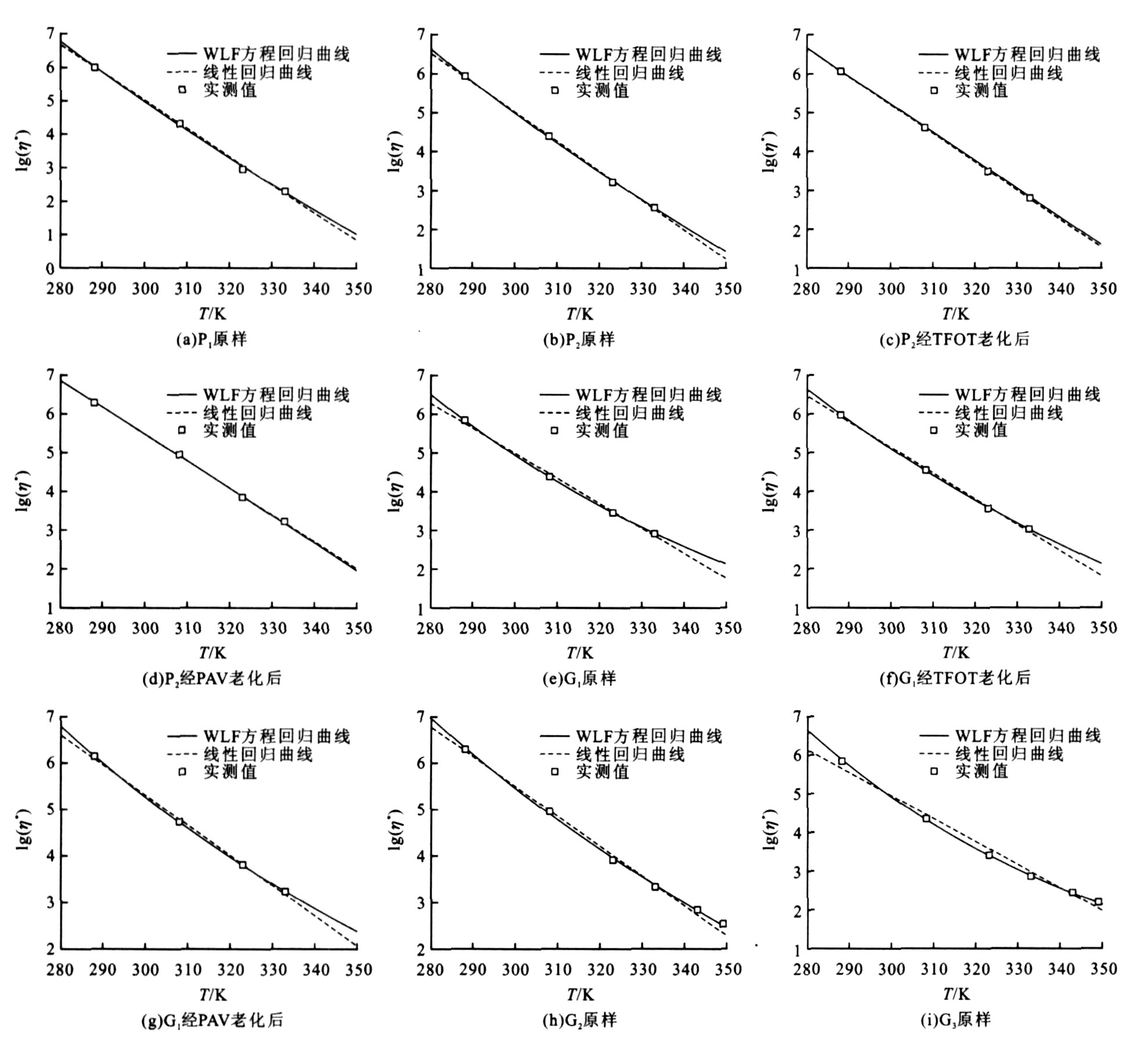Evaluation index of temperature susceptibility for asphalt
-
摘要: 为了选择合理的沥青感温性能评价指标, 分别采用15、25、30℃的针入度与25℃的针入度和软化点计算了沥青针入度指数, 用以评价2种普通沥青、3种改性沥青的感温性, 用动态剪切流变仪测得不同温度条件下几种沥青的动态复数粘度, 分析其粘-温关系。研究结果表明: 普通沥青粘-温关系在15~60℃范围内有较好的线性关系, 其温度敏感性是常数, 改性沥青的粘-温关系较好地满足WLF方程, 其温度敏感性随温度而变化, 因此, 普通沥青感温性能用针入度指数表示, 改性沥青感温性能评价需要指定温度条件。Abstract: To choose the reasonable evaluation index of temperature susceptibility for asphalt, the penetration indices of asphalt were calculated through the penetrations at 15, 25 and 30 ℃ and the penetration and softening point at 25 ℃ respectively, they were applied to evaluate the temperature susceptibilities of two kinds of common asphalts and three kinds of polymer modified asphalts(PMA), the dynamic complex viscosities of the asphalts under different temperature conditions were tested by using dynamic shear rheometer, and their relationships between viscosity and temperature were analyzed. Analysis result shows that there are linear correlations between viscosity and temperature for normal bitumens within 15~60 ℃, their temperature susceptibilities are a constant, while the relationships of viscosity and temperature for PMA satisfy WLF equation, their temperature susceptibilities change with temperature. So the temperature susceptibility of common asphalt may be expressed by using penetration index, but temperature condition must be appointed to estimate the temperature susceptibility of PMA.
-
Key words:
- pavement engineering /
- asphalt /
- WLF equation /
- temperature susceptibility /
- penetration index /
- complex viscosity
-
表 1 原样沥青针入度及针入度指数
Table 1. Penetrations and penetration indices of original asphalts
沥青种类 P1 P2 G1 G2 G3 针入度/0.1mm 15 ℃ 23.0 21.0 23.3 22.0 12.0 25 ℃ 70.0 64.0 53.0 57.0 27.0 30 ℃ 119.0 103.0 84.7 83.7 41.0 软化点/℃ 47.1 47.4 47.4 91.3 68.0 IPEN -1.14 -0.96 0.51 0.15 0.81 ITR & B -1.17 -1.31 -1.75 6.50 1.06 表 2 老化沥青针入度及针入度指数
Table 2. Penetrations and penetration indices of ageing asphalts
老化方式 TFOT(163 ℃, 5 h) PAV(2.10 MPa, 20 h, 100 ℃) 沥青种类 P2 G1 P2 G1 针入度/0.1mm 15 ℃ 17.0 19.3 14.3 13.7 25 ℃ 42.3 44.0 28.0 31.0 30 ℃ 67.7 62.3 48.0 50.0 软化点/℃ 52.5 73.5 58.0 69.6 IPEN 0.02 1.07 1.09 0.47 ITR & B -0.97 3.05 -0.65 1.61 表 3 原样沥青复数粘度
Table 3. Complex viscosities of original asphalts
Pa·s 温度/℃ P1 P2 G1 G2 G3 15 945 940 817 910 657 575 656 050 1 934 700 35 20 244 22 321 22 593 20 818 84 556 50 879 1 545 2 905 2 649 7 612 60 195 349 810 678 2 043 70 258 654 76 153 320 表 4 老化沥青复数粘度
Table 4. Complex viscosities of ageing asphalts
Pa·s 温度/℃ TFOT(163 ℃, 5 h) PAV(2.10 MPa, 20 h, 100 ℃) P2 G1 P2 G1 15 1 108 403 908 654 1 853 068 1 329 905 35 39 929 32 849 87 497 50 033 50 2 834 3 277 6 639 6 032 60 626 986 1 508 1 656 表 5 回归方程系数及相关关系
Table 5. Coefficients correlativities of regression equations
沥青种类 系数及相关性 lg[η(T)]=B′T+C′ B′ C′ R2 B C D R2 P1 -0.083 2 29.935 0.997 9 24 737.30 235.490 -41.253 0 0.998 5 P2 原样 -0.075 5 27.639 0.998 9 15 365.50 141.440 -29.849 0 0.999 7 TFOT -0.072 8 27.007 0.999 5 206 290.00 1 373.800 -118.010 0 0.999 6 PAV -0.069 2 26.233 0.999 3 189 402.00 -1 964.100 119.290 0 0.999 4 G1 原样 -0.064 7 24.400 0.995 8 2 366.52 -117.970 -8.086 8 1.000 0 TFOT -0.066 5 25.080 0.996 7 3 781.54 -70.837 -11.438 0 0.999 6 PAV -0.064 7 24.717 0.997 3 3 873.21 -64.601 -11.202 0 1.000 0 G2 -0.059 5 22.799 0.987 6 14 758.0 -159.880 -5.541 8 0.999 7 G3 -0.062 3 24.135 0.995 3 5 647.10 -16.728 -14.500 0 0.999 1 表 6 改性沥青温度敏感性
Table 6. Temperature susceptibilities of modified asphalts
沥青类型 温度/℃ 15 35 50 60 70 76 G1 0.081 4 0.065 4 0.056 2 0.051 1 0.046 7 0.044 3 G1(TFOT) 0.079 8 0.067 1 0.059 4 0.055 0 0.051 0 0.048 8 G1(PAV) 0.077 3 0.065 3 0.057 9 0.053 7 0.049 9 0.047 8 G2 0.088 1 0.066 3 0.054 7 0.048 6 0.043 4 0.040 7 G3 0.076 5 0.066 5 0.060 1 0.056 4 0.053 0 0.051 1 -
[1] 陈华鑫, 李宁利, 张争奇, 等. 沥青材料的感温性分析[J]. 长安大学学报: 自然科学版, 2006, 26(1): 8-11. doi: 10.3321/j.issn:1671-8879.2006.01.002Chen Hua-xin, Li Ning-li, Zhang Zheng-qi, et al. Temperature susceptibility analysis of asphalt binders[J]. Journal of Chang'an University: Natural Science Edition, 2006, 26(1): 8-11. (in Chinese) doi: 10.3321/j.issn:1671-8879.2006.01.002 [2] 陈佩茹, 刘炤宇. 关于沥青感温性指标的讨论[J]. 交通运输工程学报, 2002, 2(2): 23-26. http://transport.chd.edu.cn/article/id/200202006Chen Pei-ru, Liu Zhao-yu. Onindices of temperature susceptibility of asphalt[J]. Journal of Traffic and Transportation Engineering, 2002, 2(2): 23-26. (in Chinese) http://transport.chd.edu.cn/article/id/200202006 [3] 赵可, 李海骢. 改性沥青感温性评价指标的讨论[J]. 中国公路学报, 2000, 13(4): 8-11. https://www.cnki.com.cn/Article/CJFDTOTAL-ZGGL200004000.htmZhao Ke, Li Hai-cong. Discussion of the temperature susceptibility indexes of modified asphalt[J]. China Journal of Highway and Transport, 2000, 13(4): 8-11. (in Chinese) https://www.cnki.com.cn/Article/CJFDTOTAL-ZGGL200004000.htm [4] 谭忆秋, 姜丽伟, 褚浩然, 等. 三个温度针入度评价沥青材料感温性的敏感性分析[J]. 东北公路, 2001, 24(4): 42-43. https://www.cnki.com.cn/Article/CJFDTOTAL-DBGL200104014.htmTan Yi-qiu, Jiang Li-wei, Chu Hao-ran, et al. Analysis to evaluate temperature response and sensibility of asphalt material withthree temperature penetrations[J]. Northeast Highway, 2001, 24(4): 42-43. (in Chinese) https://www.cnki.com.cn/Article/CJFDTOTAL-DBGL200104014.htm [5] 陈佩茹, 孙立军. 常规沥青的针入度等级与PG高温等级间的关系[J]. 中国公路学报, 2003, 16(3): 15-17. https://www.cnki.com.cn/Article/CJFDTOTAL-ZGGL200303004.htmChen Pei-ru, Sun Li-jun. Relationship between penetration grade and performance high temperature grade of conventional asphalt binder[J]. China Journal of Highway and Transport, 2003, 16(3): 15-17. (in Chinese) https://www.cnki.com.cn/Article/CJFDTOTAL-ZGGL200303004.htm [6] Pfeiffer J P, Vandoormaal P M. The rheological properties of asphaltic bitumen[J]. Journal of the Institute of Petroleum, 1936, 22(4): 414-440. [7] Robert O R, Asce M, Robert L L, et al. Method to predict temperature susceptibility of an asphalt binder[J]. Journal of Material in Civil Engineering, 2002, 14(3): 246-252. [8] 吴其晔, 巫静安. 高分子材料流变学[M]. 北京: 高等教育出版社, 2002. [9] 曹丽萍, 谭忆秋, 董泽蛟, 等. 应用玻璃化转变温度评价SBS改性沥青低温性能[J]. 中国公路学报, 2006, 19(2): 1-6. https://www.cnki.com.cn/Article/CJFDTOTAL-ZGGL200602000.htmCao Li-ping, Tan Yi-qiu, Dong Ze-jiao, et al. Evaluation for low temperature performance of SBS modified asphalt using glass transition temperature[J]. China Journal of Highway and Transport, 2006, 19(2): 1-6. (in Chinese) https://www.cnki.com.cn/Article/CJFDTOTAL-ZGGL200602000.htm [10] 袁燕, 肖云, 张肖宁. SBS改性沥青剪切发育过程的动态力学热分析[J]. 中国公路学报, 2006, 19(3): 29-33. https://www.cnki.com.cn/Article/CJFDTOTAL-ZGGL200603005.htmYuan Yan, Xiao Yun, Zhang Xiao-ning. Dynamic mechanical thermal analysis of shearing and developing process of SBS modified asphalt[J]. China Journal of Highway and Transport, 2006, 19(3): 29-33. (in Chinese) https://www.cnki.com.cn/Article/CJFDTOTAL-ZGGL200603005.htm -





 下载:
下载:


